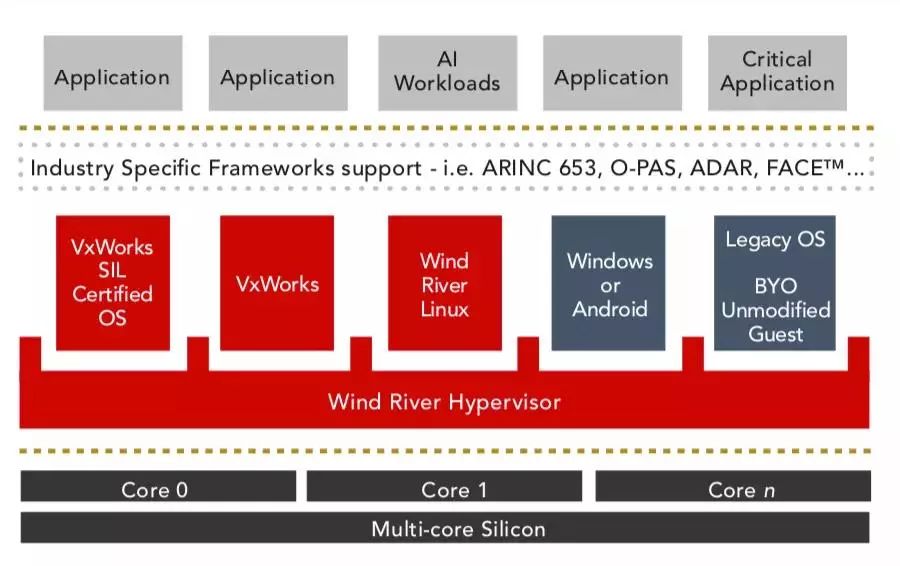
Undoubtedly, as more and more devices join the Internet of Things (IoT), traditional enterprises increasingly need support for digital transformation. This support is not just about needing to flexibly adapt to various unpredictable data usage patterns that lead to sudden and significant changes in resource demand, but also about adapting to future development needs while avoiding excessive redundant investments.
This is why Wind River Systems has focused on embedded system virtualization technology in recent years.
01

In fact, people are not unfamiliar with virtualization technology, which has been applied in enterprise IT operations for many years and is now entering the embedded systems market. It provides organizations with a solution that helps them transition from existing closed systems built for specific purposes to a modern new realm, where the new deployment method is more mobile computing-oriented, defined by software, while enhancing interconnectivity.
Today, as various industries urgently need to quickly adapt to modern software and cloud deployment practices, enterprise solutions must not only support customers’ existing applications but also help customers maintain their long-term legacy software while minimizing mandatory security regulatory costs and labor costs. This has made the development of embedded solutions far more complex than before. To address this issue, Wind River recently launched the Wind River Helix Virtualization Platform (referred to as Helix Platform).
It is understood that the Wind River Helix Virtualization Platform is a solution specifically designed to realize this evolution. It is a single platform that can run almost any embedded system, whether traditional legacy systems or modern new systems.
In fact, the Helix Platform has always been the core of Wind River technology, the Helix Platform is a highly integrated edge computing software product suite that encompasses edge to cloud, integrating quality products into the same edge computing software architecture, leveraging virtualization technology to fully utilize VxWorks capabilities, while being compatible with the openness of Linux, and possessing great flexibility to add other operating systems as needed, while also providing scalability to support the integration of legacy and new applications into the same system.
It is evident that the energy and technical performance of the Helix Platform can greatly simplify embedded solution development, aimed at addressing the evolving challenges and opportunities faced by critical infrastructure companies, enabling these companies to continuously innovate their technology and modernize their systems as they realize the full potential of IoT. Among these, virtualization technology addresses the critical challenge of how to face the complexity of today’s critical infrastructure IoT.
02
According to my understanding, Wind River’s products include operating systems, cloud infrastructure, simulation software, device management, and automotive software across various categories, widely used in aerospace and defense, industrial control, automotive, medical, and intelligent networking markets, ensuring that their computing systems run “faultlessly”. Now, the Helix Platform is providing streamlined, secure, and real-time critical infrastructure solutions for the aerospace, defense, industrial control, medical, and automotive markets.
Moreover, Wind River’s advantages are also reflected in providing leading professional services to numerous industry clients. More importantly, its rich security certification experience and strong partner ecosystem have become a technical support. To date, Wind River has served over 600 aerospace and defense customers and more than 500 security projects, with over 2 billion devices globally running Wind River technology. Most importantly, Wind River has the largest partner ecosystem in the embedded industry, including over 175 hardware suppliers, system integrators, independent software vendors, and semiconductor manufacturers, working together to help clients face the ever-changing developments and challenges.
Undoubtedly, with strong market insight, learning, and adaptability, Wind River, as embedded system virtualization develops, more software products and technologies are becoming increasingly mature, with the core functions of its software becoming increasingly important, continuously accelerating the digital transformation of critical infrastructure in a software-defined world. Through Wind River’s products, software engineers, developers, manufacturers, and system integrators can build intelligent devices, sensors, gateways, and networks, unlocking machine data and connecting it to the cloud and IT environments, thus continuously driving the entire industry to accelerate the evolution from automated devices to smarter and more autonomous systems.
This is both an advantage of Wind River and the customer value of Wind River’s products and services. To unleash the potential of virtualization in embedded systems, Wind River has launched the Wind River Helix Virtualization Platform.
It can be said that the Helix Platform is the bridge that Wind River provides for enterprises to reach future applications.
Figure 1

Helix Platform Type 1 Hypervisor Reference Architecture, supporting multiple embedded systems running on the same single chip.
As shown in Figure 1, the operating systems supported by the Helix Platform include Wind River VxWorks RTOS, Wind River Linux, Microsoft Windows, and Android, even including other unmodified “bring your own” (BYO) Guest OS. The hardware decoupling feature allows any mixed operating system to run on Intel or ARM architecture. The Helix Platform Type 1 Hypervisor runs at the processor core level, helping each application run smoothly, securely, and concurrently. The Helix Platform supports many different industry frameworks, such as the ARINC 653 software specification for the avionics industry, the O-PAS standard for industrial automation, and ADAR for the automotive industry. The Helix Platform also facilitates certification for DO-178C airborne system safety, IEC 61508 industrial functional safety, and ISO 26262 automotive safety.
03
Manufacturers using embedded system devices and solutions will gain return on investment (ROI) from the application of virtualization technology. From the perspective of operational costs, using the Helix Platform reduces the cost of purchasing dedicated hardware for developing, testing, and producing embedded systems.
Virtualization reduces both capital and operational costs while increasing revenue, thus comprehensively improving ROI. In terms of operational costs, virtualization can enhance ROI by saving multiple costs. The time taken in each stage of the product development cycle is shortened, thus reducing development expenditure. Testing and quality control are also shortened, saving on these costs. With the Hypervisor approach, there is no longer a need to hire and retain a large number of developers with scarce skills. Furthermore, as application software integration increases, the high costs of supporting early embedded systems are also reduced.
Embedded system virtualization can also increase enterprise revenue. First, the accelerated product development cycle will increase sales volume. Secondly, the increased scalability and integration can also lead to revenue growth. Devices that were originally standalone can now easily become part of an extended system with more potential customers. The reduction of capital and operational costs, combined with increased receivables, means that the ROI from embedded system virtualization is bound to be substantial.
In addition, the reuse of intellectual property (IP) also contributes to the ROI brought by virtualization. With a single platform compatible with existing embedded system software, existing codebases and Guest operating systems can be more conveniently repurposed for innovative embedded systems.
In summary, the Wind River Helix Virtualization Platform provides a solution for modernizing legacy embedded systems. It meets the security, reliability, and certification requirements of current systems, thus connecting legacy systems with new systems. The Helix Platform runs on leading hardware architectures while simplifying certification across various industries. Now, embedded system manufacturers can use the platform to shorten time to market, reduce investments, and lower capital and operational costs, thus avoiding traditional support traps. The Helix Platform provides embedded system developers with an optimal path to keep pace with the times while retaining existing investments.


